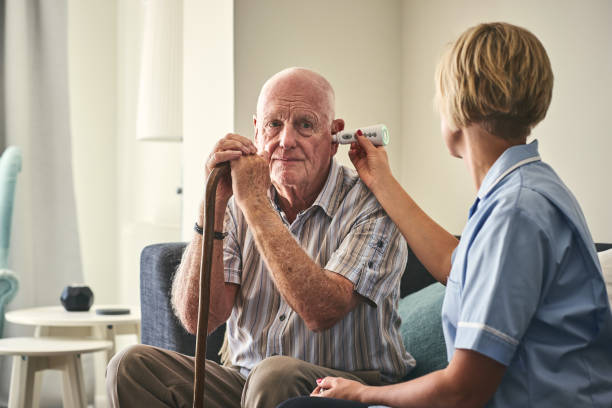Whether the fever is being treated at home or in a health facility, a nursing care plan should be laid out and followed to ensure that the patient is properly cared for. The normal body temperature of a healthy human being is thirty-seven degrees Celsius. A temporary rise in the body temperature of a person is known as a fever.
Fever mainly occurs as a symptom arising from other infections and diseases.
The common causes of fever are: viral infections such as flu, bacterial infections, fungal infections, food poisoning, etc.

Read our popular article " How Long Are Viral Infections Contagious?"
The nursing care plan for fever
A fever could be home treated if it just occurred or taken to the hospital to seek further assistance if symptoms persisted.
This also ensures that the fever is well treated to prevent its deterioration.
A proper care plan for fever should include assessing the patient, making a diagnosis, planning, intervention, and finally, evaluation.
1. Assessment of the patient
Assessing the patient involves checking their body temperature, checking their bodies for visible signs and symptoms, for example, rashes, and even observing, for example, checking to see if the patient is restless.

2. Diagnosis
Once the assessment is complete, a diagnosis can be made, concluding whether the patient is running a fever or not. A diagnosis involves identifying whether the patient is sick or not, and if they are seeking, then identify the cause of their illness.

For instance, in our case, a diagnosis may be made, concluding that the patient is running a fever due to a recurring infection. For example, the flu or the fever results from dehydration.
3. Preparation of a nursing care plan
On completion of the diagnosis, a plan is then prepared. This plan should entail the process that the nurse will intervene to treat the fever.
First, the nurse will identify the urgency of the situation and decide on how to treat the patient. An urgent condition will require a plan that involves direct treatment of the patient.
For instance, the flu that occurs due to the flu does not need an urgent reaction to treat it. However, a fever resulting from a rise in the blood pressure of a patient calls for urgency.
The plan also lays out the processes and procedures that the nurse will put into action while treating the fever. For instance, the plan could clearly state how they will approach the fever, how it brings it down, measures they can take to ensure the temperature remains normal, and how to check on the patient at intervals to ensure that the treatment mode is working.

The plan will also state the medicines to be given to the patient, if any. Lastly, planning also involves stating the expected outcomes once treatment is complete.
4. Intervention
This simply involves the implementation of the nursing care plan. A complete nursing intervention of a person with fever mainly involves: decreasing the production of the body heat, monitoring and maintaining body functions, promote body heat loss and promoting comfort.
It is the actual treatment of the patient. There are several steps involved in the intervention of a nursing plan for fever.
They include:
a. Monitor the condition

This is done to determine why intervention is needed in the first place and also to determine the effectiveness of therapy. For instance, on determining the patient’s condition, the nurse can be able to decide how to decrease the temperature. This means that in the instance that the body temperature is too high, a sponge bath may be the best choice to decrease the body temperature.
In contrast, if the situation is not that serious, the nurse may advise the patient to take a complete rest to minimize unnecessary energy use, which may raise the body temperature.
b. Assess the underlying condition and body temperature
This procedure is carried out to acquire comparative baseline data and to identify and assess the contributing factors. After identifying these factors, the nurse can now treat the patient while also ensuring that these factors have been eliminated and avoided.
The nurse can also advise the patient to avoid these factors in the future. In the long-run, this avoids further exposure of these factors to the patient hence avoiding them suffering from fever again.

c. Monitor the vital signs
By monitoring the patient’s vital signs, the nurse can come up with measures that will further help lower the body temperature.
For example, a patient may be having a fast heartbeat rate. On realization, the nurse identifies first what could be causing the fast heartbeat rate. Then they may advise the patient on measures they can take to reduce the pace of the heartbeat and, as a result, lower the patient’s body temperature.

- Remove unnecessary clothing that could, as a result, be causing the aggravated raise in the temperature.
- Promote a well-ventilated area for the patient. Ensure there is a free flow of air in and out of the room. This can be done by leaving the windows open, and also a fan could come in handy.
- Encourage the patient to increase their fluid intake. The patient could take, for example, a lot of water, fruit juice, or even soda.
- Promote adequate rest periods. Encourage the patient to rest and avoid activities that will lead to an increase in metabolism. Sleep is a necessity.
- Advise the patient to increase the intake of calorie diet, for example, proteins. This is because they help in lowering the body temperature.
- Administer antipyretic as prescribed by the physician in order to aid in further lowering down the body temperature.
5. Evaluation

Once the intervention is over, the nurse should evaluate the situation. This simply involves checking on the patient to see whether the treatment was productive and that the patient got better.
For example, determine whether, after a given period, the patient could see the main core temperature within the normal range. If not, the nurse should go through the procedure all over again while identifying the factors that may be hindering the patient from recovery.
References
Gulanick, M., & Myers, J. L. (2011). Nursing care plans: Diagnoses, interventions, and outcomes. Elsevier Health Sciences.
Kusoom, W., & Charuwanno, R. (2017). Concept mapping: An effective strategy for clinical teaching in nursing. Pacific Rim International Journal of Nursing Research, 21(4), 263-266.
Sardinha, D. M., Costa, G. F., Cunha, L. C., Mafra, I. N. P., da Silva Silva, M. R., de Matos, W. D. V., … & leite de Lima, M. V. (2019). Nursing care in severe traumatic brain injury. International Journal of Advanced Engineering Research and Science, 6(12).
